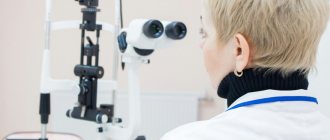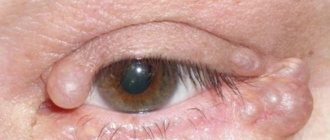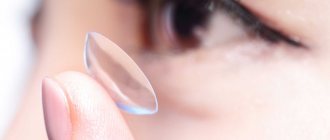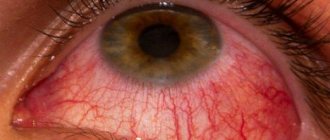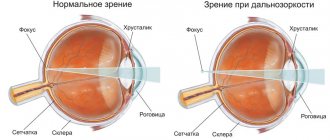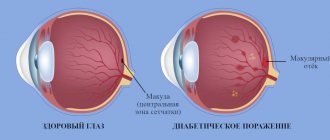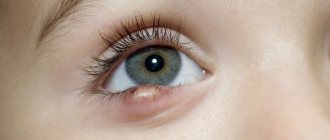Hypermetropia is a common visual impairment, which is expressed in the patient’s inability to clearly see objects located close to him. But he clearly sees objects at a long distance.
Farsightedness is a type of refraction. Light rays are focused behind the retina, resulting in an image being formed behind the retina of the eye. This leads to the fact that objects at close range look blurry and do not have clear contours.
Causes
Hypermetropia occurs due to the irregular shape of the eyeball. Often pathological changes occur in childhood. The fact is that all children have congenital farsightedness, but as the child grows, his eyeballs grow, and his vision becomes normal. This usually happens by the age of 4 years.
Over time, the lenses lose their ability to change. This begins to happen at the age of 25, but usually until the age of 45 it is not felt at all. At the age of 60, the lens completely loses this ability. This is why senile farsightedness occurs.
Causes
The causes depend on many factors, including age. For example, in older people, the elasticity of the lens weakens, which causes farsightedness to appear as a normal phenomenon. In children after birth, the manifestation of this disease is also not considered a pathology, as long as the indicators do not go beyond the normal range.
In addition to the normal physiological development of hypermetropia, it can occur due to:
- Flat shaped cornea.
- Shortened eyeball.
- Decreased accommodative capabilities of the lens.
The disease does not appear out of thin air. The causes of such pathologies are:
- Hereditary factors. If parents are diagnosed with farsightedness, then in more than half of the cases, this disease will be passed on to the child.
- Presence of pathologies. Some of the most common causes are secondary diseases: diabetes, cancer, astigmatism and others.
- Congenital form. Bad habits of the mother, poor nutrition and stress can affect the development of hypermetropia in the child even at the stage of fetal formation.
In other cases, farsightedness is an age-related phenomenon. At a young age, it is enough to do gymnastics and devote more time to physical development. This will help form a stronger eye system and get rid of mild hypermetropia.
Degrees of farsightedness
There are 3 degrees of hypermetropia:
- Weak – up to 2 diopters;
- Medium – up to 5 diopters;
- High – over 5 diopters.
Weak degree
Often there are no obvious symptoms. Patients do not notice any negative changes. Pathological changes in vision occur almost imperceptibly. With weak farsightedness, objects can be clearly visible from any distance. But patients often complain of eye fatigue after several hours of intensive work at the computer or after reading, dizziness, and headaches.
Average degree
More noticeable. The patient constantly moves objects away from his eyes in order to see them better. Visual acuity also decreases in low light conditions. At the same time, objects in the distance remain clearly visible. Additional symptoms include eye fatigue and eye pain.
High degree
High degree hypermetropia is characterized by a significant decrease in vision at any distance. It becomes difficult for the patient to see objects not only close up, but also at a long distance. Additional symptoms include rapid eye fatigue (literally an hour in front of a computer monitor becomes a real test), a feeling of sand in the eyes, and severe headaches.
Farsightedness: treatment. Sequence and stages
Initial examination
First, you will be asked about what exactly is bothering you. Tell us everything in detail - when you noticed that your vision has deteriorated, what symptoms are accompanied by it, what stress you have, and what you did to improve the situation. Do not forget to take with you to the consultation documents on your disease - an outpatient card, reports, extracts, examination results. This will help the doctor restore the picture of the disease and select the optimal methods for treating farsightedness. Next, the doctor conducts an examination using special equipment. The examination takes up to 30 minutes, it does not cause discomfort, and provides all the necessary information for selecting treatment for adults and children.
Norm and pathology for hypermetropia
Hypermetropia is normally present in young children (1-3 years old), does not cause concern and does not require treatment. During the period of development between infancy and school age (up to 6-7 years), active growth occurs, the child’s body weight increases, and internal organs and systems develop. Particularly active development occurs in the visual system - an exact ratio of the functionality of different parts of the eyeball is developed.
In children by the age of four, this defect in visual perception disappears. Experts believe that it is possible to detect the disease and distinguish it from the norm from the first months of life. If farsightedness is detected in children above the age-normal value, treatment is required.
It is very important to begin therapy immediately after diagnosis, as school-age children are subject to increased eye strain. In the future, in the absence of eye correction, the symptoms of hypermetropia intensify.
Symptoms of farsightedness in children
Determining pathological farsightedness, especially moderate and weak degrees, is much more difficult than myopia. However, parents should pay attention to the following features in the child’s behavior that may indicate the development of this anomaly:
- He rubs his eyes with his hands when reading or looking at pictures in books;
- At times he blinks frequently or opens his eyes wide and then closes his eyes tightly, thus trying to relieve visual tension;
- When playing with small parts (for example, puzzles, construction sets), the child moves them further away from himself, assembling them at arm's length;
- Refusal to draw, sculpt, or other activities that require concentration on small details should also be a warning sign. The child subconsciously tries to distance himself from what causes eye strain, but is not yet able to explain this due to his age;
- Unreasonable lacrimation, as well as the frequent occurrence of inflammatory diseases of the organs of vision: blepharitis, conjunctivitis and the like;
- Repeated complaints of headache, dizziness, pain in the eyes.
As school begins, children begin to get tired quickly, receive poor grades, cannot concentrate on assignments, and have trouble sleeping and concentrating. Parents attribute this to inattention, restlessness, and careless attitude, whereas it is farsightedness in children that can cause such phenomena. Diagnostics will help identify the presence of pathology, if any.
Lens replacement.
Unfortunately, it is impossible to completely eliminate age-related decline in the quality of vision, since over time the lens inevitably wears out and loses its properties, but a person can delay the onset of presbyopia. To do this, you need to maintain visual hygiene, avoid excessive strain on the eyes, monitor your diet, take vitamins and microelements, and perform visual exercises. Of the hardware techniques, devices that improve the trophism of eye tissue, microcirculation, optic nerve conductivity, methods of accommodation training, and chromotherapy can help delay the development of presbyopia.
Diagnostics
Hypermetropia is rarely detected during routine vision testing . To establish pathology, ophthalmologists use instrumental studies:
- biomicroscopy;
- visometry to determine visual acuity using a table;
- skiascopy;
- ultrasound diagnostics;
- refractometry;
- intraocular pressure tonometry.
If necessary, magnetic resonance imaging or fluorescein angiography of retinal vessels is performed. A complete study of the visual system helps the doctor prescribe the correct method for restoring vision.
Prevention
To prevent vision loss, a patient with hypermetropia must follow these rules:
- turn on the overhead light or table lamp on the left side;
- do eye exercises every 30-60 minutes of work;
- alternate eye strain with rest;
- eat right, including vegetables, fruits, and fish products in your diet;
- carry out general strengthening treatment - massage of the collar area, swimming, race walking 30-40 minutes a day.
For average farsightedness, it is recommended to visit an ophthalmologist every six months.
A patient with moderate hyperopia must constantly take care of his eyes. Preventive measures and visiting a doctor every six months help avoid progression to a severe stage. Advanced hypermetropia is dangerous for the development of glaucoma and the addition of other diseases.
Author: Lyudmila Plekhanova, doctor, especially for Okulist.pro
Treatment
With moderate farsightedness, the patient experiences constant discomfort and performance decreases. At this stage, a person must take urgent therapeutic measures. There are three proven methods of vision correction - glasses, contact lenses and laser correction.
Glasses
The most common and safe type of treatment for moderate hypermetropia is wearing glasses. They can be removed if not necessary, giving your eyes a rest. The use of even very high-quality optics does not provide 100% visibility and gradually reduces peripheral vision.
Lenses
Soft lenses are prescribed for children and adults. This contact correction is especially indicated for amblyopia, because it stimulates the visual apparatus well. With average farsightedness, they are indispensable for vision correction along with glasses.
But contact lenses have some disadvantages:
- cause allergic reactions;
- require constant observance of visual hygiene.
Laser treatment
A modern method of correcting farsightedness is the use of a laser. For patients over 18 years of age, LASIK surgery is used. The technology corrects farsightedness up to 5 D and astigmatism.
The method has the following advantages:
- speed – the duration of the operation does not exceed 15 minutes;
- low morbidity;
- the manipulation does not affect the internal tissues of the eye and is performed only on the cornea.
There is no recovery period required after laser intervention. The patient sees well within 2 hours after the procedure.
Causes and pathogenesis of farsightedness
The blurriness of objects viewed at close range is explained by the fact that refracted rays converge to a focal point behind the retina. Depending on the etiology, refractive and axial farsightedness are distinguished; a combination of these types of disease is also possible.
Refractive farsightedness develops as a consequence of weakness of the refractive system of the eye. This is possible, for example, if there is no lens or a flattened cornea.
Axial farsightedness is most often congenital and develops due to shortening of the anteroposterior axis of the eyeball.
The so-called hidden farsightedness often occurs, which manifests itself with age. In young people, visual acuity is maintained due to the tension of accommodation of the eye, that is, self-correction, which is possible due to the ability of the eye to enhance its refraction (refractive power).
Recommendations for parents.
Parents must remember and understand that a visual defect that begins at an early age can seriously affect the development and health of the child in adulthood. If a pathology is identified and hardware treatment is prescribed, the following rules must be observed:
- Before coming for procedures, prepare your child for the upcoming treatment, including psychologically. This is especially important for young children. Explain to the child that it is not painful or scary, that he just came to train his eyes. Therapeutic training for children under 4 years of age is carried out in the presence of parents. From the age of 4, children can easily complete tasks independently.
- It is necessary to provide moral support to the child before and during treatment sessions. Encourage, stimulate, praise.
- It is important to monitor the results of treatment, but do not expect a positive effect after the first procedures. Please be patient, this process is not quick.
- Follow all instructions and recommendations of the doctor, including wearing glasses or contact lenses. Don't neglect your homework. As a rule, between courses of therapeutic training, the doctor gives recommendations on wearing glasses, gluing the eyes, and performing special eye gymnastics at home. Teach your child to calmly, without hysterics, wear glasses and apply stickers.
- It is important to prepare mentally for a long period of elimination of defects in vision and visual apparatus.
- Provide your child with a healthy lifestyle, feasible physical activity, proper nutrition, rich in vitamins and minerals.


